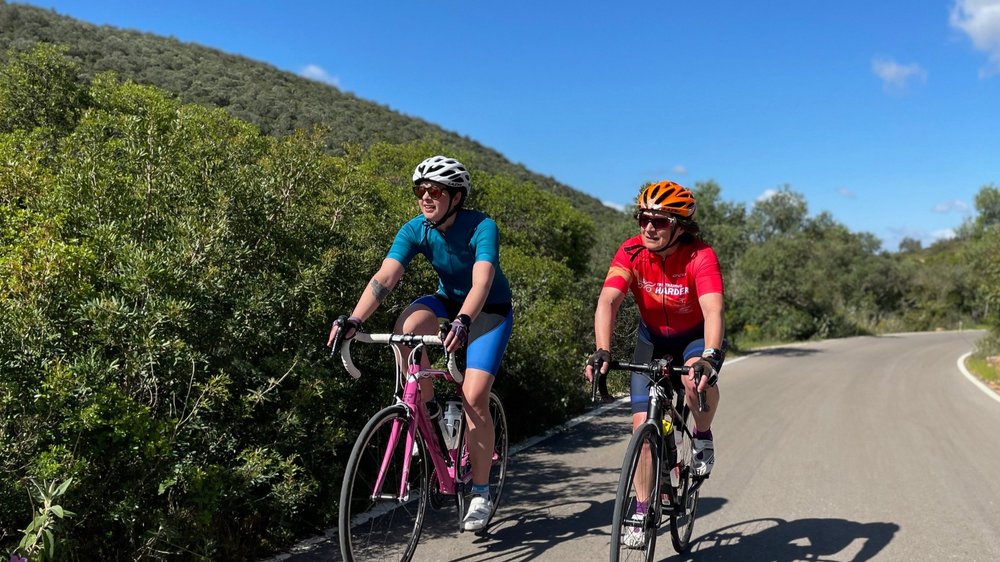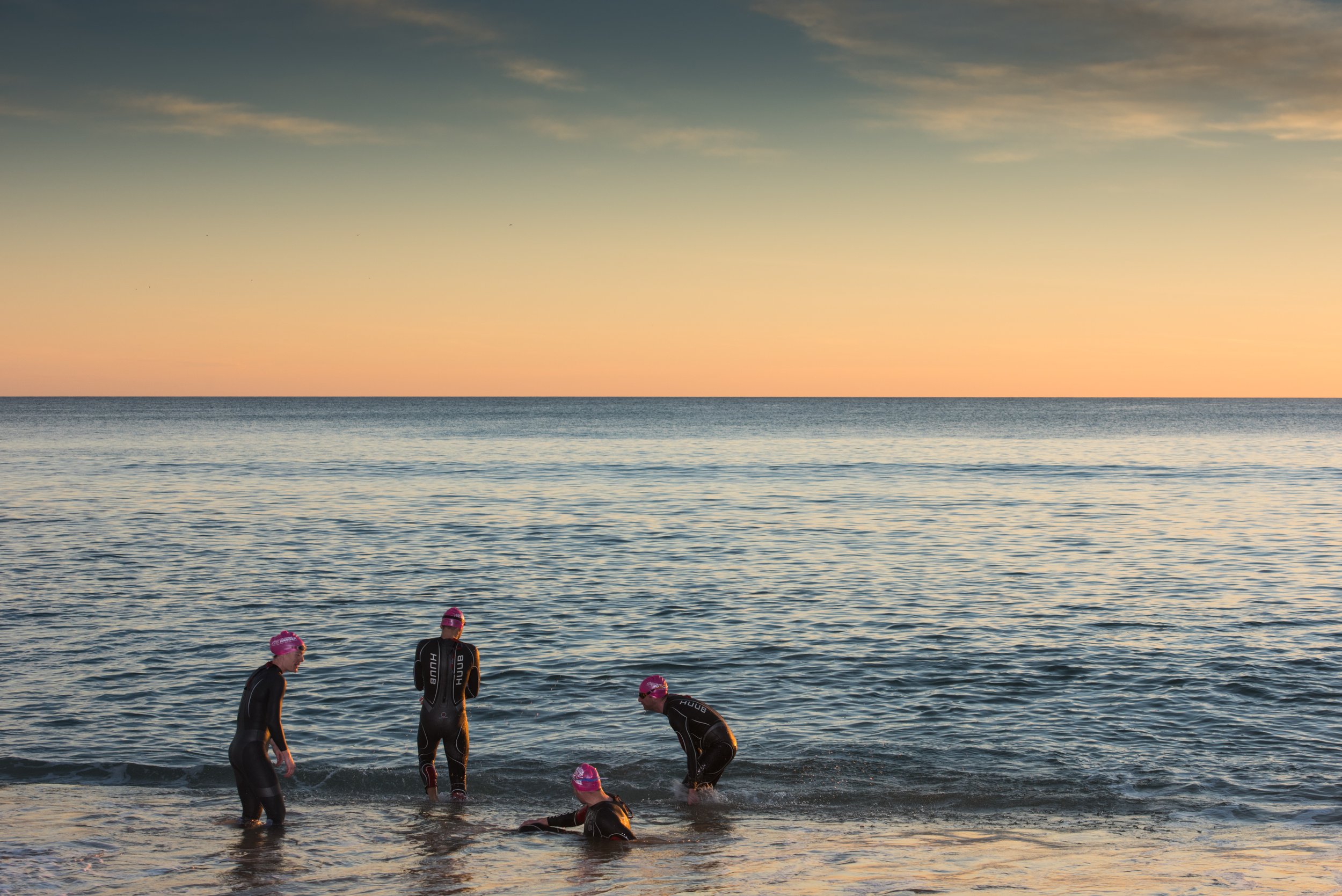Cold water swimming advice
Most triathlons feature an open water swim, and familiarity with the water really helps on race day. Many triathletes swim in their local lakes, rivers or sea during training season but stop once the water and air temperatures drop. In this article, coach Denise looks at why and how you can swim outside all year round.
Swimming outside is one of the nicest ways to get into the water. There is no chlorine smell, no aqua-aerobics class taking up half the pool, no heads-up breaststroke swimmers in the fast lane and no sweaty bodies jumping into the pool straight from the sauna (despite all the notices to shower first).
Pool swimming does have one advantage over swimming outside, especially in the UK and especially in winter – the water and the environment are warm. Just because the weather and water are getting colder, this is no reason to retreat to the pool for the duration of the winter months. With a bit of preparation, and some determination, it is entirely possible to swim (almost) anywhere and any when.
You can take two basic approaches to swimming outside all year round.
Firstly, decide to embrace the cold, avoid the neoprene as much as you can, and stick with wearing a swimsuit and hat. Known in the open water (OW) swimming community as swimming skins, this approach works well for many people. As the temperature drops, regular swimming will allow the body to acclimatise to the lowering temperatures. Adding neoprene gloves and socks can help with cold tolerance, as can wearing two swim hats, one of which could be neoprene. Some swimmers even believe that wearing two swimming costumes helps to keep them warmer.
Secondly, wearing as much neoprene as possible can help to keep you swimming for longer in the colder waters. This is especially true if you don’t live right next to the water and so cannot get into it as regularly. Wearing a wetsuit, gloves and socks, as well as full-face goggles and a neoprene hat, will help to keep you swimming regularly throughout the winter months.
In the summer months, bodies of water such as lakes and slow-moving rivers warm up much faster than the sea. If you are looking for the warmest place to swim, then somewhere shallow with a low water stream through it would be your best bet, though these can then be prone to swimmers’ itch or blue-green algae. The sea is cooler than fresh water in the summer since it is a large body of water which takes longer to heat up and cool down, though some shallow beaches can be very warm. This is where local knowledge is invaluable.
In the winter, the sea, as a large body of water, will retain its heat more than a lake or river. Temperatures in the sea will vary a lot in the winter around the UK, with minimum temperatures in Scotland being around 4 or 5°C, but more like 9°C off the Devon coast. It is not uncommon for lakes to freeze anywhere in the UK, meaning the water temperature will be below 4°C.
While thinking about frozen bodies of water, there is an approach to cold water swimming, which is much more about exposure to the cold than swimming. There are many claims about the physical and mental benefits of this, though most have not been proven. This approach tends to focus on getting into water, as cold as possible, for a short period of time. This tends to be referred to as dipping rather than swimming.
Whatever approach you take to where you swim and why, there are some considerations as you get into the water. As your body goes into cold water, there is an instinctive reaction to inhale sharply, known as cold water shock. Regular exposure to cold water will reduce this. Also, entering the water carefully can help to overcome it. To enter the water, walk in slowly; getting your hands and wrists into the water will help to cool the blood. Then splash water onto your neck and face. Before you submerge your torso and shoulders, take a deep breath, then exhale slowly as you sink into the water. This will help to control your breathing. Once in the water and moving around, swimming whatever stroke, will keep the body warm. As you get comfortable, then start to put your face under. Swim to stay warm. Remember to smile and enjoy it. If you are wearing a wet suit, one cheat is to pour warm (not hot) water into the suit just before you get in. This will then mingle with the water you are swimming in, so your exposure to it is less of a shock to the system.
At some point, and the length of time will depend on your level of acclimatisation, clothing and exact water temperature, you will get cold. Your body is a pretty clever piece of biological engineering. It knows that your core must stay warm to protect the vital organs, and if necessary, it will sacrifice your extremities to protect the core. This means that your blood will retreat from your limbs and stay within your torso if you are in a cold environment. This is tolerable for a while, but at some point, you need to remove yourself from the situation, or you are at risk of hypothermia. If you start to lose motor control (you can’t touch each finger in turn on one hand to the thumb) or the water begins to feel warm, this is a strong signal to get out of the water quickly. Swimming hard just before exiting the water will also help move the blood around a bit.
Warming up effectively once out of the water is important, especially if the air is cold, it is raining (or snowing), or it is windy. Get the wet clothing off, whatever you are wearing, fast and rub yourself dry with a towel or a dry robe. Have a hot drink to hand for when you get out, and drink something as soon as possible, so you are heating up from the inside out. A sugary snack, known in Scotland as a Shivery Bite, will also help start the warming process. Putting on layers of easy-to-don dry clothes, warm socks, and gloves helps a lot.
Do not be tempted to have a hot shower, as this can warm the skin surface up too fast and be counterproductive. A warm shower can help, though, if you are close to one. Many people use a hot water bottle, and while this is great for keeping your clothing warm while you are swimming, do not put it right against your skin, as the contact of the hot water bottle onto cold skin may cause some issues.
These precautions are all there to minimise after drop. After drop can occur around 20 – 40 mins after getting out of the water. The exact mechanism is under discussion. It was thought that as you warm, the blood starts to go back into the cold limbs that cool the blood. This cooler blood is pumped back to the core and lowers the core body temperature. More recently, Mike Tipton has shared the theory that conduction from the cold outer layers of the body continuing when out of the water is a more likely mechanism. Whatever is happening, if you get after drop, you will start to feel very cold and shivery just when you thought you were warming up. If this happens, make sure you sit down, have more warm drinks and layer up well. Do not drive until your core temperature has recovered.
Whatever approach you take, I would encourage you to try open water swimming in the cold, especially if you have been swimming outside regularly this summer. The chances are you’ll meet lots of other swimmers in the popular spots, you’ll be more than ready for whatever water temperature you have on race day in 2023 and avoiding all that chlorine is a bonus.
The best piece of advice I got as I started out swimming outside was:
‘It’s your swim, what you wear, how long you swim for and what stroke you do are all your choice and have nothing to do with anyone else’.

Denise has been coaching triathletes since 2019 as a coach at her local triathlon club in West Lothian. Between 2019 and 2022, Denise was the Head coach in the club, working with a team of coaches to support and develop triathletes with a wide range of capabilities, completing her BTF Triathlon Level 2 coaching qualification in 2021.
Denise joined Tri Training Harder as a coach in 2021, building on the qualifications through the experience and knowledge passed on by the coaching team.
In 2019 Denise set up and continues to run her own Jog Scotland running group, a mixed ability group of runners who meet weekly. This delivers on her passion for helping people to do much more than they think they can.
Visit Denise's
Coach profile
We’re here to help
Tri Training Harder are one of the leading Triathlon coaching providers in the UK, using our wealth of experience to unite scientific and technological research with already well-established and successful best practices, to create a formula for triathlon and endurance coaching that works.
The result is an honest, dynamic, yet simple new way of constructing an athlete’s training to allow them to reach their potential.
If you’re planning your next season, just starting out in the sport or are looking for extra guidance at the very top end of the field, we are here to help, and our coaches would be delighted to hear from you. You can contact us via the website, and one of the team will be in touch.

